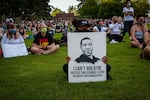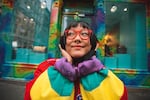Ameya Marie Okamoto was sitting bored at a mock-trial retreat her sophomore year of high school. Half tuned in, she hid her social media scrolling and Photoshop doodling from the group spiritedly discussing their case.
It was then Okamoto's phone rang. Teressa Raiford, founder of the activist group, Don't Shoot Portland, was calling. Stepping outside to answer, Okamoto heard Raiford urgently relay that a seventeen-year-old was shot and killed in East Portland by the police. "We have to get this out ASAP," instructed Raiford.
Okamoto immediately grabbed her laptop, sat down in a corner and went to work.

A memorial portrait of Quanice Hayes illustrated by Ameya Marie Okamoto. Hayes was shot and killed by Portland Police in 2017.
Courtesy of Ameya Marie Okamoto
Two hours later an illustration of Quanice Hayes in a blue jacket and white hooded sweatshirt, looking into the distance as pink sky dances behind him, was sent off for distribution. Okamoto also posted it to her Instagram page. And in an even shorter time span than it took to create, the image went viral on social media.
“Apparently it started trending 'Justice for Quanice Hayes.’ My friends started sending me screenshots of everybody with their profile photos with my image,” Okamoto remembers.
While local news organizations were still sharing an outdated mugshot of Hayes several years younger, profile pictures nationwide had been changed to Okamoto’s image of Quanice Hayes.
“It’s the power of digital art,” Okamoto claims.

An attendee holds up a protest sign for the vigil of George Floyd at Peninsula Park in Portland, Ore., Friday, May 29, 2020. The sign features an illustration of George Floyd made by Minneapolis-based artist Andres Guzman.
Claudia Meza / OPB
The faces of protest
Memorial portraits like the one Okamoto made for Quanice Hayes have taken a central role in the iconography of protests and social justice movements across the country in recent years.
Related: Beyond Protests: 5 More Ways To Channel Anger Into Action To Fight Racism
As protests erupted over the death of George Floyd at the hands of the Minneapolis police, portraits of him began to spread across the internet through artists' Instagram pages. Very quickly, these were the images most seen in the hands of demonstrators.
In one, he’s surrounded by a ring of flowers with “Justice for George” written across the top. In another, he stands before a bright sunflower with the names of others killed by police in its center. In a third, he simply stares straight ahead, in a simple but bold black vector illustration, easily printable for signs and banners.
Memorial portraits are not new; they have been around for many decades in communities plagued by violence. But they usually take the form of tattoos, murals, airbrushed t-shirts, even custom automobile art. They were created as an alternative to images that might depict their friends, their family members, as perpetrators rather than whole people.
A portrait for the family
Okamoto, a social practice artist who grew up in Portland, has crafted dozens of portraits for victims of violence and injustice. Those include Christopher Kalonji, who was shot dead by Portland police in 2016 and Taliesin Myrddin Namkai-Meche, murdered by a white supremacist on a Portland MAX train in 2017.
Rather than concentrating her efforts on producing for high-dollar museum shows, she focuses on creating art to exist in the streets, or in the hands of the people most affected by police shootings: siblings, parents, spouses.
Okamoto says the goal of her portraits is to evoke a subject’s humanity: the fact that they are real people, with stories and loved ones.
Okamoto recounts delivering her portrait to Quanice Hayes’s family at a candlelight vigil.
“I’m searching for his family and it’s super emotional,” she says. “I walked up to his dad and he’s like ‘Oh, you’re Ameya.’ I took the poster out and I remember his grandma giving me a hug. It was really powerful to see how his friends reacted to seeing their friend, their sibling, memorialized that way ... that was kind of the key moment where it clicked for me the power that memorial portraits have on families.”

Memorial portrait of Christopher Kalonji by artist Ameya Marie Okamoto. Christopher Kalonji was shot dead by Portland Police on Jan. 28, 2016.
Courtesy of Ameya Marie Okamoto
Reclaiming complex personhood
Okamoto says she keeps that power in mind when creating her work. She warned that when you create a portrait that centers on victimhood or death, it can strip away the person’s individual humanity. And that runs the risk, she said, of reducing a person with a rich life to a hashtag.
“People get so attached to the hashtag and the movement of George Floyd or Quanice Hayes,” she said, “they forget that George Floyd was a trucker who moved to Minneapolis for a better life, or that Quanice Hayes was actually called ‘Moose’ by his friends and family.’”
Related: The New Sounds Of Protest And Hope
“When individuals become catalysts for Black Lives Matter and catalysts for social change,” she continued, “there is a level of complex personhood that is stripped away from them.”
As an Asian American woman, Okamoto was once unsure if she was the right person to create portraits in Black-centered activism. But Raiford and others in the Black Lives Matter movement assured her she was needed. This informed her perspective on social activism to be more inclusive.
“I always say that there is a place for everyone in justice work,” Okamoto said. “There is a place for everyone because there HAS to be a space for everyone for us to be able to take down the system.”
When asked why she thinks her portraits and others are such effective protest signs she said, “People are fascinated by other people — the power in illustrating an individual is giving the viewer or giving the audience an opportunity to be like, ‘I could have known them.’”

Ameya Marie Okamoto is a social practice artist who grew up in Portland. She partners in making art with many progressive organizations but is largely known for her memorial portraits centered around the Black Lives Matter movement.
Courtesy of Ameya Marie Okamoto
Ameya Okamoto offers all her work online for free for nonprofit use only with a $10 suggested donation to Don’t Shoot Portland.
